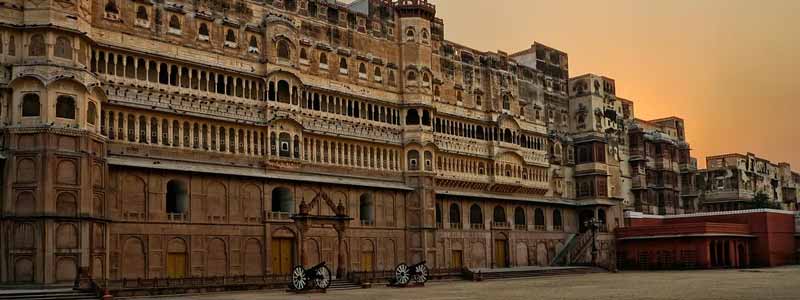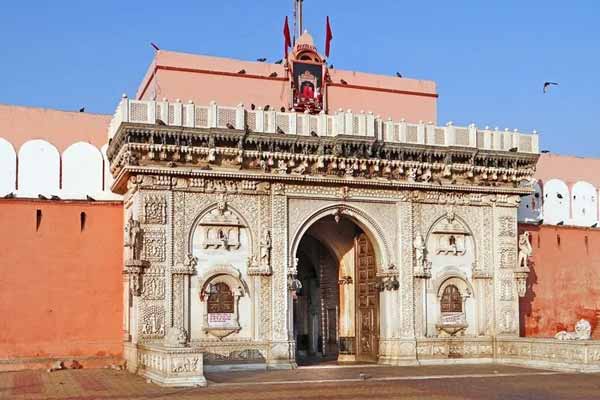10 Best Places To Visit In Bikaner is home to one of the only two models of the biplane used by the British during World War I. They were presented by the British to Maharaja Ganga Singh, then ruler of the city. Another unique aspect about Bikaner are the sand dunes that are scattered throughout the district, especially from the north-east down to the southern area. Bikaner is situated in the northern region of Rajasthan. One of the earlier established cities, Bikaner still displays its ancient opulence through palaces and forts, built of red sandstone, that have withstood the passage of time.
The city boasts of some of the world’s best riding camels and is aptly nicknamed ‘camel country’. It is also home to one of the world’s largest camel research and breeding farms; as well as being known for having its own unique temple dedicated to Karni Mata at Deshnok, called the Rats Temple.
The origins of Bikaner can be traced back to 1488 when a Rathore prince, Rao Bikaji, founded the kingdom. Legend has it that Bikaji, one of Rao Jodhaji’s five sons, left his father’s Durbar in annoyance after an insensitive remark from his father, the illustrious founder of Jodhpur. Bikaji travelled far and when he came upon the wilderness called Jangladesh, he decided to set up his own kingdom and transformed it into an impressive city, Bikaner Tour Packages.

Junagarh Fort
If you are a history buff, then there can be no better tourist place in Bikaner for you to put at the top slot in your itinerary than the majestic Junagarh Fort. Undefeated and unconquered, this fort stands proudly till date and narrates the heroic tales of the glorious history of the place.
A unique amalgamation of the Mughal as well as Gujarati architectural styles, the architectural brilliance of the place is one of the factors which makes this place so much popular among travellers from all over the country. The soaring beauty and the mesmerising surroundings of the fort are impressive too. There are a plenty of historical structures to explore within the Junagarah Fort including Royal Chapel, Public Hall, Chandra Mahal and Anup Mahal, all of which are unique in their own way. There is also a fort museum located within the premises which is worth a 10 Best Places To Visit In Bikaner.
- Distance from Jaipur, Rajasthan: about 333.7 km away
- Location: Junagarh Fort Road, Bikaner, Rajasthan 334001
- Opening Hours: You can visit the place anytime from 10 AM till 5 PM.
- Ideal for: History Buffs, Photographers, Architecture lovers
Karni Mata Temple
This temple is also known as the Nari Mata Temple or Rat Temple and is one of the best places to visit in Bikaner. It is located almost 30 kilometers away from Bikaner. This 600-year-old temple is truly unique. In this temple, 25,000 black rats live, and these are worshiped the temple. These rats are known as Kabbas, 10 Best Places To Visit In Bikaner.
In this temple, the food that gets eaten by the rats is considered holy. The rat-eaten foods are served as prasad among the devotees. People all around the world come here to visit this temple. Several legends and tales are related to this temple. This temple is significant for its architecture as well. The fantastic marble facade and marble carvings enhance the beauty of this temple.
- Distance from Jaipur, Rajasthan: about 334.3 km away
- Location: NH 89, Deshnok, Bikaner, Rajasthan 334801
- Opening Hours: You can visit the place anytime from 5 AM till 10 PM. It is open on all days of the week.
- Ideal for: Offbeat travellers, pilgrims, art admirers
National Research Centre on Camels
This is a must-visit place in Bikaner as intense research takes place here. This is a breeding nursery as well as a research centre where you can spot three different breeds of camels. Almost 230 camels are sheltered here. Visitors can also experience an onsite camel milk station where you get to taste the camel milk as well as lassi.
Some other activities that can be experienced here are camel rides, exploring the camel museum and exploring the entire research centre.
Reasons to visit: If you are fascinated by these humped animals then a visit to the National research centre on camels is a must 10 Best Places To Visit In Bikaner.
Commute: The camel research centre is just 8 km away from Bikaner hence tourists can easily hire a cab to this location.
Entry Fee: Starting fee is INR 150 Per Person
Gajner Palace and Wildlife Sanctuary
This beautiful palace is located in the city of Bikaner. Gajner Palace was built by Maharaja Ganga Singh. This palace was the hunting lodge for him and his family. Later in 1976, it was converted to a hotel. If you want to indulge yourself in several leisure activities, then Gajner Palace will be the perfect destination for you. From boat riding to desert safari, here you can attempt almost everything, 10 Best Places To Visit In Bikaner.
This palace represents the architectural beauty of the guests. You can also enjoy several recreational activities like lawn tennis, billiards, bird watching, cycling, etc. When you come to Gajner Palace, make sure to enjoy the wildlife safari here. This palace represents both ancient and modern culture.
- Distance from Jaipur, Rajasthan: about 370 km away
- Location: Kolayat, Gajner, Bikaner, Rajasthan 334301
- Opening Days: You can visit the place anytime as it is open on all days of the week.
- Ideal for: History buffs, peace lovers, nature lovers, wildlife enthusiasts, bird watchers
- Entry Fee: There is a meagre entry fee of Rs. 100.
Lallgarh Palace
It is a breathtaking Rajasthani Palace that is situated in the beautiful city of Bikaner. Between 1902 and 1926, this beautiful palace was constructed for the Maharaja of Bikaner. This beautiful palace was built in European architecture style. Now, it is open for tourists as a Heritage Hotel.
Also, now it comes under the National Heritage Trust. Lallgarh Palace includes a museum named Shri Sadul Museum. If you want to explore the authentic Rajasthani Royalties, you must explore this spectacular palace. The extravagant lifestyle under the palace will surely captivate you. The entire palace is built of red sandstone bought from the Thar Desert.
Rampuria Haveli
One thing for which the city of Bikaner is immensely popular would definitely be its magnanimous havelis which are symbolic of its royal and glorious past. Sporting intricate carvings, traditional jharokas and a unique heritage charm, Rampuria haveli is one such popular sight-seeing destination in Bikaner. Built by the rich merchants of Bikaner, this haveli is believed to be over a few hundred years old. A visit to this haveli will immediately transport you back to the era of exuberance, beauty, majesty and royal life. Allowing you to imagine the luxurious life that the city of Bikaner experienced a few decades back, this place is often frequented by a plenty of tourists from all over the country.
- Distance from Jaipur, Rajasthan: about 335.3 km away
- Location: Joshiwara, Old Bikaner, Bikaner, Rajasthan, 334001
- Opening Hours: This haveli is open on all days of the week for all of the 24 hours of the day.
- Ideal for: The place is ideal for those who wish to see the royal and heritage side of the city.
Sadul Singh Museum
If the city of Bikaner intrigues you and you have this curiosity to know more about the place, then there can be no better tourist place to visit in Bikaner than Sadul Singh Museum for you. Dedicated to the Maharajas of Bikaner, including Maharaja Ganga Singh, Maharaja Sadul Singh and Maharaja Karni Singh, it is one of its kind of a museum. Boasting of housing some of the precious collection of artefacts associated with the royal families such as paintings, weapons, photographs and trophies, this museum is a true delight to explore for every history buff.
This museum is often visited by many people who wish to have a sneak peak of the plenty of heroic things which the Maharajas of Bikaner did during their reign 10 Best Places To Visit In Bikaner.
- Distance from Jaipur, Rajasthan: about 335.3 km away
- Location: Samta nagar, Bikaner, Rajasthan 334001
- Opening Hours: You can visit the place anytime from 10 AM till 5 PM.
- Ideal for: History buffs
Shri Laxminath Temple
For all those people who are looking forward to indulge in some spiritual sightseeing during the trip to this beautiful city, Shri Laxminath temple should be the popular sight-seeing place to visit in Bikaner for you. Boasting of being one of the oldest temples of the city, this popular temple is dedicated to the sanctum of Goddess Laxmi and Lord Vishnu. The thing which sets this temple apart from the rest of the lot is the intricate silver artwork and beautiful idols of the several deities, 10 Best Places To Visit In Bikaner.
Pilgrims and devotees from all over the country come to visit this temple throughout the year but the crowd here is unimaginable during the festive season. The temple boasts of organise massive celebrations for some Hindu festivals such as Diwali, Ramnavami and Janmashtami.
- Distance from Jaipur, Rajasthan: about 337.2 km away
- Location: Vaidya Mangaram Colony, Bikaner, Rajasthan 334004
- Opening Hours: You can visit the place anytime from 5 AM till 1 PM or from 5 PM till 11 PM. It is open on all days of the week.
- Ideal for: Pilgrims, art admirers, architectural buffs, festive lovers
Kodamdesar Temple
This temple was built by Rao Bikaji- the founder of Bikaner. Kodamdesar Bheruji Temple has religious significance, and Hindus praise this temple a lot. Here, the temple is Lord Bharu Ji. This lord was born from the place between the eyebrows.
Some people believe that Lord Bhairu Ji got birth from the third eye of Lord Shiva. Therefore, the lord is also considered an incarnation of Lord Shiva and his ferocious form 10 Best Places To Visit In Bikaner.
Sursagar Lake
Constructed by Maharaja Sur Singh, this lake which was once constructed in order to curb the problem of water shortage, now serves as one of the top tourist places to visit in Bikaner. Owing to its scenic beauty, this man – made lake also proves to be a great picnic spot. The serene location makes the visit to the lake all the more irresistible. You will be pleased to know that the visitors are even allowed to go boating in the Sursagar lake. Since the surrounding areas of the lake are pretty well – maintained and have good seating arrangements, a lot of travellers and locals frequent the spot 10 Best Places To Visit In Bikaner.
- Distance from Jaipur, Rajasthan: about 333.5 km away
- Location: Junagarh Fort Road, Bikaner, Rajasthan 334001
- Opening Hours: There are no specific timings to visit the place.
- Ideal for: Picnic, Nature lovers, Photographers
A perfect blend of history, adventure, rich tradition and delicious cuisine, 10 Best Places To Visit In Bikaner is one complete fun package for a memorable, thrilling and relaxing getaway.
